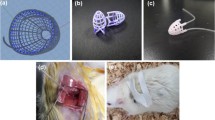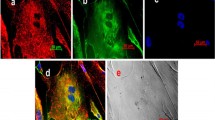Abstract
Objective: To investigate the directed transplantation of allograftic bone marrow-derived mesenchymal stem cells (MSCs) in myocardial infarcted (MI) model rabbits. Materials and Methods: Rabbit were divided into 3 groups, heart infarcted model with MSCs transplanted treatment (MSCs group, n=12), heart infarcted model with PBS injection (control group, n=20), sham operation with PBS injection (sham group, n=17). MSCs labelled by BrdUrd were injected into the MI area of the MSCs group. The same volume of PBS was injected into the MI area of the control group and sham group. The mortality, LVIDd, LVIDs and LVEF of the two groups were compared 4 weeks later. Tropomyosin inhibitory component (TnI) and BrdUrd immunohistochemistry identified the engrafted cells 4 weeks after transplantation. Result: The mortality of the MSCs group was 16.7% (2/12), and remarkably lower than the control group’s mortality [35% (7/20) (P<0.05)]. Among the animals that survived for 4 weeks, the LVIDd and LVIDs of the MSCs group after operation were 1.17±0.21 cm and 0.74±0.13 cm, and remarkably lower than those of the model group, which were 1.64±0.14 cm and 1.19±0.12 cm (P<0.05); the LVEF of the MSCs group after operation was 63±6%, and remarkably higher than that of the model group, which was 53±6% (P<0.05). Among the 10 cases of animals that survived for 4 weeks in the MSCs group, in 8 cases (80%), the transplanted cells survived in the non MI, MI region and its periphery, and even farther away; part of them differentiated into cardiomyocytes; in 7 cases (70%), the transplanted cells participated in the formation of blood vessel tissue in the MI region. Conclusion: Transplanted allograftic MSCs can survive and differentiate into cardiomyocytes, form the blood vessels in the MI region. MSCs transplantation could improve the heart function after MI.
Similar content being viewed by others
References
Bittira, B., Kuang, J.Q., 2002. In vitro preprogramming of marrow stromal cells for myocardial regeneration. Ann Thorac Surg, 74(4):1154–1160.
Chen, J., Li, Y., Wang, L., Zhang, Z., Lu, D., Lu, M., Chopp, M., 2001. Therapeutic benefit of intravenous administration of bone marrow stromal cells after cerebral ischemia in rats. Stroke, 32:1005–1011.
Cohen, M.V., Yang, X.M., Downey, J.M., 1999. Smaller infarct after preconditioning does not predict extent of early functional improvement of reperfused heart. Am J Physiol, 277:1754–1761.
Donald, O., Jan, K., Stefano, C., 2001. Mobilized bone marrow cells repair the infarcted heart, improving function and survival. Proc. Natl. Acad. Sci, 98(18): 10344–10349.
Federico, Q., Konrad, U., 2002. Chimerism of the transplanted heart. N Engl J Med, 346:5–15.
Lang, R., Gomes, A.V., Zhao, J., Housmans, P.R., Miller, T., Potter, J.D., 2002. Functional analysis of a troponin I (R145G) mutation associated with familial hypertrophic cardiomyopathy. J Biol Chem, 277(14):11670–11678.
Le, B.K., Tammik, L., Sundberg, B., Haynesworth, S.E., Ringden, O., 2003. Mesenchymal stem cells inhibit and stimulate mixed lymphocyte cultures and mitogenic responses independently of the major histocompatibility complex. Scandinavian Journal of Immunology, 57(1):11–17.
Lu, D., Mahmood, A., Wang, L., Li, Y., Lu, M., Chopp, M., 2001. Adult bone marrow stromal cells administered intravenously to rats after traumatic brain injury migrate into brain and improve neurological outcome. Neuroreport, 12:559–563.
MacFarlane, N.G., Darnley, G.M., Smith, G.L., 2000. Cellular basis for contractile dysfunction in the diaphragm from a rabbit infarct model of heart failure. Am J Physiol Cell Physiol, 278:c739-c746.
Mann, D.L., 1999. Mechanisms and models in heart failure: A combinatorial approach. Circulation, 100:999–1008.
McGinley, J.N., Knott, K.K., Thompson, H.J., 2000. Effect of fixation and epitope retrieval on BrdUrd indices in mammary carcinomas. J Histochem Cytochem, 48:355–362.
Min, J.Y., Yang, Y., Converso, K.L., Liu, L., Huang, Q., Morgan, J.P., Xiao, Y.F., 2002. Transplantation of embryonic stem cell improves cardiac function in postinfarcted rats. J Appl Physiol, 92:288–296.
Ohno, M., Takemura, G., Ohno, A., Misao, J., Hayakawa, Y., Minatoguchi, S., Fujiwara, T., Fujiwara, H., 1998. “Apoptotic” myocytes in infarct area in rabbit hearts may be oncotic myocytes with DNA Fragmentation. Ciculation, 98:1422–1430.
Pennock, G.D., Yun, D.D., Agarwal, P.G., 1997. Echocardiographic changes after myocardial infarction in a model of left ventricular diastolic dysfunction. Am J Physiol, 273:2018–2029.
Peter, J.Q., Pamela, S.B., 1998. Stem cell homing: rolling, crawling, and nesting. Proc. Natl. Acad. Sci, 95:15155–15157.
Pittenger, F., Mackay, A., Beck, S., 1999. Multilineage potential of adult human mesenchymal stem cells. Science, 284:143–147.
Podesser, B., Wollenek, G., Seitelberger, R., Siegel, H., Wolner, E., Firbas, W., Tschabitscher, M., 1997. Epicardial branches of the coronary arteries and their distribution in the rabbit heart: The rabbit heart as a model of regional ischemia. The Anatomical Record, 247:521–527.
Schmitt, B., Ringe, J., Haupl, T., Notter, M., Manz, R., Burnester, G.R., Sittinger, M., Kaps, C., 2003. BMP2 initiates chondrogenic lineage development of adult human mesenchymal stem cells in high-density culture. Differentiation, 71(9–10):567–577.
Shinji, M., Fukuda, K., Shunichirou, M., 1999. Cardiomyocytes can be generated from marrow stromal cells in vitro. The Journal of Clinica Investigation, 103(3):697–705.
Tomita, S., Li, R.K., Weisel, R.D., 1999. Autologous transplantation of bone marrow cells improve damaged heart function. Circulation, 100(19):247–256.
Wang, J.F., Wu, Y.F., Harrintong, J., McNiece, I.K., 2004. Ex-vivo expansions and transplantations of mouse bone marrow-derived hematopoietic stem/progenitor cells. J Zhejiang Univ SCIENCE, 5(2):157–163.
Wasan, K.M., Sivak, O., 2003. Modifications in lipoprotein surface charge alter cyclosporine A association with low-density lipoproteins. Pharm Res, 20(1):126–129.
Author information
Authors and Affiliations
Additional information
Projects (No. 30240075) supported by the National Natural Science Foundation of China
Rights and permissions
About this article
Cite this article
Wang, Ja., Li, Cl., Fan, Yq. et al. Allograftic bone marrow-derived mesenchymal stem cells transplanted into heart infarcted model of rabbit to renovate infarcted heart. J. Zheijang Univ.-Sci. 5, 1279–1285 (2004). https://doi.org/10.1631/jzus.2004.1279
Received:
Accepted:
Published:
Issue Date:
DOI: https://doi.org/10.1631/jzus.2004.1279




